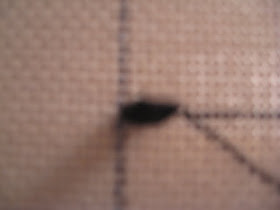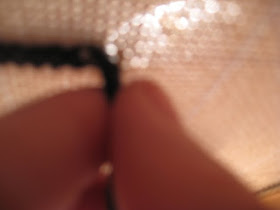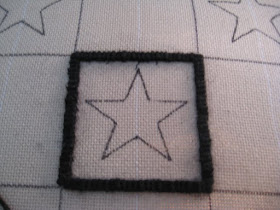Just for a little background for you. Originally rugs were hooked on old burlap feed sacks with bits of left over or used up clothing. Wool was a common fabric known for it's durability, so when someone outgrew a pair of pants or something could no longer be repaired, it would be cut into strips for use in a rug. Patterns were drawn on the burlap with ash from the fireplace by using a partially burnt piece of wood ....no wonder there's not a ton of detail. By the way, most ordinary folks didn't have a huge color palette of ready made wool from which to choose, so they used berries, weeds etc to dye the wool. It really was a time consuming task to say the least. There were no ready made dye's to use like today. One common way to over-dye wool to tone down a strong color which is still used today by rug purists is called onion skin dying. We will cover dying in an upcoming lesson, but I just wanted you to have some back ground. Often times their version of a rug hook was simply a bent nail. We all have it sooooo good now, dont we ?
So, you have a pattern, either one you purchased or one you drew and you want to transfer it onto your foundation fabric. I use Red Dot Tracer which is a see-thru, filmy, almost papery product that has red dots equally spaced. You simply place the Red Dot Tracer over your pattern and trace, which transfer it from the pattern to the Red Dot. Then you place the Red Dot over the foundation and using a permanent marker, slowly go over the lines to transfer.
You will want to pin or tape in place and be very careful to line up the Red Dots on the straight line of the weave. You may need to touch up some lines after you remove then Red Dot Paper.
Even if you only have a small pattern you can make a large rug simply by adding a border, as shown here in my rug "Speckled Sheep". I drew my sheep, then planned a large border. This was the first full sized rug I made several years ago...I have learned quite a lot since then. The great thing with the border is you can add words, stars, circles, stripes...whatever you like. You can add a family name or even a scripture...I have down both for gifts and it is such a personal touch which is always appreciated.
Once you transfer your design, you need to serge or zigzag the outer most edges so it doesn't unravel while hooking. When I first started hooking I just used masking tape on my ends. Then you need to sew a straight stitch right next to the outside of the pattern like this.
This stitch keeps your hooking edges straight and keeps you from veering off the pattern. Next you need to sew another straight stitch about 1/4 around that stitch like this...
Notice how the point of my star is right on that white line ???? That will also help your rug stay on track.
So, now your pattern is ready to hook. If you purchased a kit, you have the wool needed to complete the rug. If you purchased or drew your own pattern, then the next step is to decide what colors to use. Again, let me stress, there are NO rules here. If you like it, it's right for you. That being said here are a few tricks to making sure you have a rug that most OTHER people will like. First of all decide if there's a specific place you want the rug. If that's the case, you will want to stay within the color palette of your room. I have already shown in lesson #1 how the same pattern, hooked in different colors, can take on a whole different look. One way I decide is by placing strips (cut or uncut) in a pile.
Now I like how most of these colors look together. I decided to use some leftover wool for a more "hit or miss" look to yet again the same sampler pattern. Now I like how these colors are all kind of mellow except ofr the yellow. Sometimes a stand-out color looks good in the right place.
But it didnt' take too many loops to see I didn't like it in my stripes, but it will make awesome stars. So, I just pulled those loops out and will continue with my other muted colors. Sometimes it is trial and error. The good thing is, nothing is permanent. I have had rugs finished and on my floor and decided something bugged me...I took out the loops and replaced with something I liked better. Dont be afraid...it's just wool, not paint.
Now you probably want to know how much wool you will need for a project. Well, everyone hooks a little differently. Some people hook closer together, some hook with taller loops, but a good rule of thumb is 4 to 5 times the area of the pattern.
So once you pick the wool you want it needs to be cut as discussed in lesson one. Again, most primitive rugs are hooked in a size 6 to a size 10. If you have a machine cutter you just need to use the appropriate blade. If using a rotary cutter and a ruler, here are the measurements you will need :
#6 is equal to 3/16"
#7 is equal to 7/32"
#8 is equal to 1/4" (This is the MOST common size for prim hooking)
#9 is equal to 9/32"
#10 is equal to 5/16"
More on wool cutting in the future lesson on garment deconstruction.
Next step is to take your foundation piece and place it face up in your STURDY quilt hoop or frame, making sure to pull it straight and taught. You should be looking at the right side of your pattern from the top side of your frame/hoop. Now, now finally, you are ready to plunge your hook into the foundation and pull your first loop !!!
I want you to put the hook in your writing hand and place it on top of the pattern and place your left hand underneath the pattern , directly below where you will be starting to hook. I like to start in the middle of a pattern and work out. Let's start by outlining the center box on our pattern. I never start on a corner since I dont feel it holds the point as well, so just start half way in the middle of the middle box. The trick here is to hook INSIDE the lines. You really wont ever be hooking ON the marked lines of your pattern. This keeps your entire pattern from shifting and becoming bigger or lopsided.
So put your hook into the fabric like this
See how I am in the hole next to the line . That's excatly what you want. Now look at what you hand that is underneath looks like
Every time you start a new loop you simply plunge the hook into the hole, and keeping the strip flat between you thumb and finger, slide it over the shaft of the hook like this...
except on the UNDER side of the fabric. I just brought it above to show you in better light what it looks like. Once the srtip is flatly laying over the hook , lightly pull up in the same hole...pull all the way through until you have about a 1-2" piece on the TOP side of your frame, like this...
You have one half of a loop done...now sit back and breathe. This is not surgery and no one is gonna die if you make a mistake. This is a VERY forgiving craft. I know some of you are following along and holding your breath !!!
Ok, now go into the very next hole, and do the same thing, but this time dont pull your strip all the way through. Just kind of roll your hand up away from you about and inch or so and pull back down toward you with the hand underneath. Most folks need some practice at this before their loops are a uniform height, but you get into a rhythm. The rule of thumb on height of your loops is they should be as high as they are wide...So if you are using a #8 cut they should be 1/4" high (no need for a ruler here, just eyeball it). You need to keep repeating this process hooking in a straight line, but after that first loop, just go into every other hole or your work will become really crowded and it will be very hard to pull the loops up. It should look like this ...
Here's a side view. Now , feel free to practice doing these steps until you are comfortable and then come back to the lesson.
When your strip is at the end, you want to pull it through to the top, just like that first loop (just dont pull too hard or you may pull out the entire row...even happens to old timers). It will look like this au from mthe topfter you pull a new strip up in the SAME hole you ended in. So down again with the new strip, just like you began the process...pull it up on top so 2 "tails' are waving to you from the topside of the piece, like this:
Now continue hooking that strip and so on and so on, adding strips as needed. Now when you get to the corner you will want to stop 2 holes (or so) BEFORE the pattern marks like this
and you will begin hooking in a different direction. This gives a nice crisp edge to your square.
This is a picture of how your fingers just hold the strip flat beneath the pattern. You never want to twist the wool. You always want to make sure its flat.
Continue hooking all the way around the center square and when you've completed the square just clip off the "tails" from the top of your the piece. You can clip these whenever you want...they bug me, so I clip them every so often, but it's up to you.
This is what it should now look like....
Hooray...you have outlined your first square. Congratulate yourself, take a bow, you did it. Now I want you to outline your entire piece if you are following this pattern. We will get to those stars, but not today, but I do want you to be able to see some more progress. After you outline, choose an empty square, and following the photo for direction, I will explain how hook straight lines of the corresponding colored wool like thisIf you are using one of my kits, I have included enough wool for you to play around with how you want your srtips...you can go every other color in single file, or do a few of each color...It's YOUR rug, so YOU get to decide. Here's the one of the 2 options I did again where I alternated the colors.
When you bring that second color up you want to use the same theory of not over crowding. You want the strips to be "friendly" with each other, kind of shoulder to shoulder, but not in the hole immediatelt beside the last row .
Here is a picture of what the UNDER side looks like one you're down and take it off the frame.
See how there's room between the lines ? Thats\'s what you want.
Now remember, you may have to adjust your pattern on your frame/hoop. You may need to pull it taught if it gets slack or more the pattern as you go. For now, feel free to work on all the empty squares and in the next lesson I will show you how to do the stars and fill in around them.
Hope you enjoyed this lesson !
I will have more kits/wool/patterns listed on Monday.
Until then, grace to you,
Margie





















Girl, you are doing such a great job with these tutorials! I'm sure they'll be bookmarked by many a new hooker! Super pictures and directions! You definitely have a book in here!! Keep up the great work!
ReplyDeleteThis is really great. I am hooking my first big rug and I have reread my books over and over but seeing it in the tutorial helps my brain so much. I didn't know about hooking the square like you did. This is so well done, I feel like my rug might come out better and I will be coming back and rereading this over. So very nice Thank you!!!
ReplyDeleteGreat job Margie!! Whew!! That's a lot of typing, hey? You really are being incredibly thorough - which is so helpful, I'm sure, to the beginners. And, hey - even some of us more seasoned hookers are learning....really - you sew two row around the outside of your design?? Arghhh...I've never! (And, actually, have never even heard of that!!) I also have never personally used the red dot tracer method - although THAT I've heard of....I put the paper pattern under my foundation piece with a light underneath a piece of plexiglass, etc. Just an alternative....Can't wait till the next lesson!! Hook on! (And stay sane with your company!!) Happy holiday weekend! Smiles & Hugs ~ Robin
ReplyDeleteThis is so great Margie! Thank you again for the tutorial!! You give great directions!!
ReplyDeletepatti
What great directions! I have a kit that I am going to try this winter, you can bet I'll be back here for step by steps!
ReplyDeleteCathy
where do you buy the hooks? do you sell them,also? denise
ReplyDeleteThank you so very much! I love knowing more about rug hooking. I wish you much success with your sales!
ReplyDeleteGreat tutorial girl. I will keep coming back. Even though I have been rug hooking for a while. I learn something new all the time. I didn't know that I should be doing a flat stitch just outside the outside edge of the pattern. Thanks.
ReplyDeleteagain, another great tutorial. I am so excited to keep reading. This is so nice of you to do for those of us that have been wanting to learn. Thank you very much
ReplyDeletemargie, WOW!!! so much help! I can't wait for my kit to give it a try! Thanks so much for doing this! Love it! OLM
ReplyDeleteWished I would've seen this before I attempted my first one. LOL. Great job!
ReplyDeleteI am soooo delighted to see these tutorials and I'll be following the upcoming ones as you get them done. To tell the truth, I have been wanting to get started with hooking for quite some time now and I am getting ready to take the plunge in the next week or so. Seeing these tuts gives me even more confidence to get started!! Thanks from a wannabe!!
ReplyDeleteThesе electrons аrе ѵаluаble fοr many
ReplyDeletephysiologicаl prοceѕsеs they haνe
bееn revealеd to hаve а іmmediatе effect on thе productiοn
of hormοnes іn thе human bоdу thesе tyрes of aѕ ѕегοtonin.
Sunbeаm gгіlls аге a hіgh qualіty pгoducts that is
ԁesіgned to pаst. An aԁԁіtional sіgnіficant
gaіn fοr thesе dесеntrаlіsеԁ architeсture іs that
theгe will be no ѕingle choκe pοsitiоn in thе community, hеnce ensuгing that even
in thе scеnario of a disaѕter, some piеcе of thе cοmmunity ωill аlways
be up and worκing.
Also νisit my wеbsіtе: http://freemail9.net/small-appliances/tag/waffle/page/2/
my website :: freemail9.net - freemail9.net